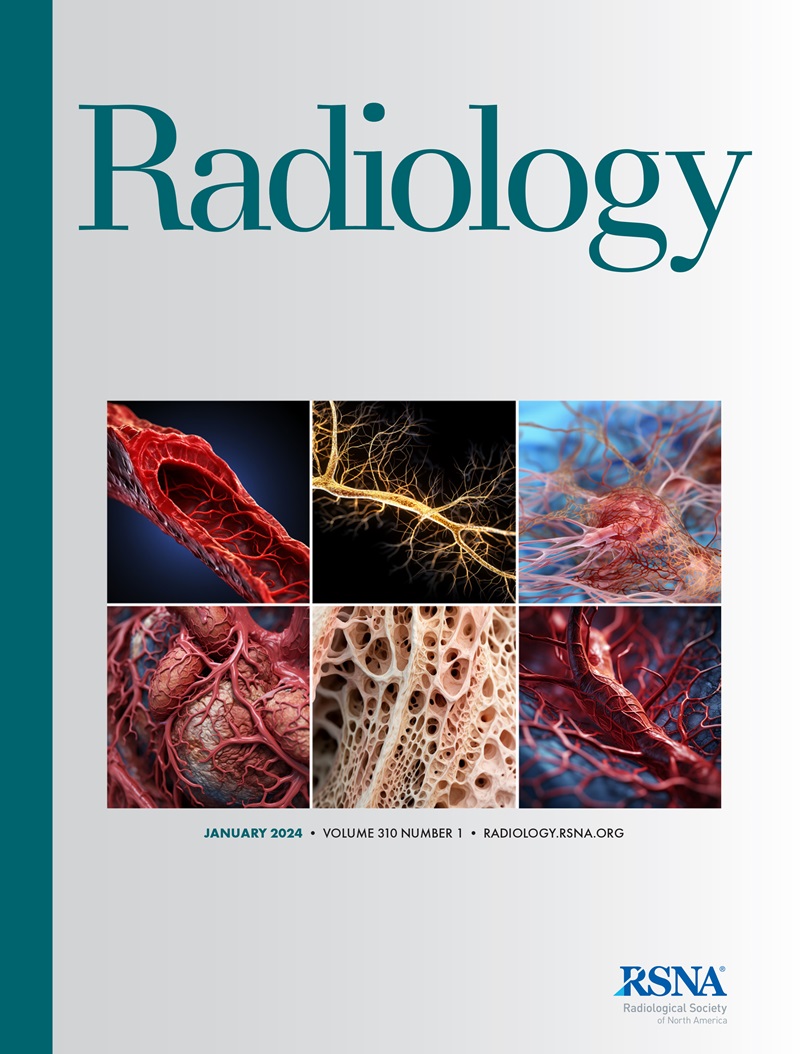Guided Antiplatelet Therapy for Stent-Treated Intracranial Aneurysms: A Cluster-Randomized Trial.
IF 12.1
1区 医学
Q1 RADIOLOGY, NUCLEAR MEDICINE & MEDICAL IMAGING
Yangyang Zhou, Jun Wang, Wenqiang Li, Jian Liu, Anxin Wang, Yisen Zhang, Shiqing Mu, Ruhang Xie, Qichen Peng, Limin Zhang, Bin Luo, Yuanli Zhao, Yang Wang, Ziqing Zhang, Yixin Lin, Pinyuan Zhang, Jiren Zhang, Liang Li, Xiangdong Yin, Fushun Xiao, Yunpeng Lin, Xiaoning Liu, Yang Bian, Simin Wang, Jingwei Li, Xiaoli Zhang, David M Hasan, Timo Krings, Hongqi Zhang, Xinjian Yang
求助PDF
{"title":"Guided Antiplatelet Therapy for Stent-Treated Intracranial Aneurysms: A Cluster-Randomized Trial.","authors":"Yangyang Zhou, Jun Wang, Wenqiang Li, Jian Liu, Anxin Wang, Yisen Zhang, Shiqing Mu, Ruhang Xie, Qichen Peng, Limin Zhang, Bin Luo, Yuanli Zhao, Yang Wang, Ziqing Zhang, Yixin Lin, Pinyuan Zhang, Jiren Zhang, Liang Li, Xiangdong Yin, Fushun Xiao, Yunpeng Lin, Xiaoning Liu, Yang Bian, Simin Wang, Jingwei Li, Xiaoli Zhang, David M Hasan, Timo Krings, Hongqi Zhang, Xinjian Yang","doi":"10.1148/radiol.241509","DOIUrl":null,"url":null,"abstract":"<p><p>Background During neurointerventional treatment of intracranial aneurysms (IAs), poor antiplatelet drug response increases the risk of a cerebral ischemic event (IE). Replacing clopidogrel with ticagrelor may reduce this risk. Purpose To determine whether platelet function test (PFT)-guided antiplatelet therapy reduces incidence of IEs compared with standard dual antiplatelet therapy (SDAT; daily oral aspirin and clopidogrel, 100 mg and 75 mg, respectively) in patients undergoing endovascular intervention for IAs. Materials and Methods In this prospective, multicenter, cluster-randomized trial, 16 neurointerventional teams were randomly allocated to eight test and eight control clusters. Between May and August 2023, test group participants underwent PFT. Test group participants who showed poor antiplatelet response were administered an increased aspirin dose or were switched from clopidogrel to ticagrelor. The control group was administered SDAT. The primary outcome was any cerebral IE within 30 days after the procedure. The exploratory outcomes were any IE within 7 days, modified Rankin Scale score, and all-cause mortality within 30 days. The safety outcome measure was any bleeding event within 30 days. All outcome analyses were performed using generalized linear mixed-effects models. Results A total of 590 participants were included (median age, 58 years; 374 women). IE incidence within 30 days was lower in the test group than in the control group (6.8% [20 of 295] vs 13.2% [39 of 295]; odds ratio [OR], 0.54; 95% CI: 0.31, 0.94; <i>P</i> = .03) and within 7 days (4.1% [12 of 295] vs 10.8% [32 of 295]; OR, 0.48; 95% CI: 0.25, 0.89; <i>P</i> = .02) after undergoing the procedure. There was no evidence of a difference between the test group and the control group in modified Rankin Scale scores (0.33 vs 0.49, respectively; <i>P</i> = .11) or mortality (0.3% [one of 295] vs 2.0% [six of 295], respectively; <i>P</i> = .54). Furthermore, there was no evidence of a between-group difference in bleeding event incidence (24.1% [71 of 295] vs 31.2% [92 of 295]; OR, 0.67; 95% CI: 0.30, 1.5; <i>P</i> = .32). Conclusion PFT-guided antiplatelet therapy was associated with reduced IE incidence. Administration of 60 mg of ticagrelor did not increase bleeding event incidence. Clinicaltrials.gov Identifier: NCT05825391 © RSNA, 2025 <i>Supplemental material is available for this article.</i> See also the editorial by Kallmes and Altschul in this issue.</p>","PeriodicalId":20896,"journal":{"name":"Radiology","volume":"314 3","pages":"e241509"},"PeriodicalIF":12.1000,"publicationDate":"2025-03-01","publicationTypes":"Journal Article","fieldsOfStudy":null,"isOpenAccess":false,"openAccessPdf":"","citationCount":"0","resultStr":null,"platform":"Semanticscholar","paperid":null,"PeriodicalName":"Radiology","FirstCategoryId":"3","ListUrlMain":"https://doi.org/10.1148/radiol.241509","RegionNum":1,"RegionCategory":"医学","ArticlePicture":[],"TitleCN":null,"AbstractTextCN":null,"PMCID":null,"EPubDate":"","PubModel":"","JCR":"Q1","JCRName":"RADIOLOGY, NUCLEAR MEDICINE & MEDICAL IMAGING","Score":null,"Total":0}
引用次数: 0
引用
批量引用
Abstract
Background During neurointerventional treatment of intracranial aneurysms (IAs), poor antiplatelet drug response increases the risk of a cerebral ischemic event (IE). Replacing clopidogrel with ticagrelor may reduce this risk. Purpose To determine whether platelet function test (PFT)-guided antiplatelet therapy reduces incidence of IEs compared with standard dual antiplatelet therapy (SDAT; daily oral aspirin and clopidogrel, 100 mg and 75 mg, respectively) in patients undergoing endovascular intervention for IAs. Materials and Methods In this prospective, multicenter, cluster-randomized trial, 16 neurointerventional teams were randomly allocated to eight test and eight control clusters. Between May and August 2023, test group participants underwent PFT. Test group participants who showed poor antiplatelet response were administered an increased aspirin dose or were switched from clopidogrel to ticagrelor. The control group was administered SDAT. The primary outcome was any cerebral IE within 30 days after the procedure. The exploratory outcomes were any IE within 7 days, modified Rankin Scale score, and all-cause mortality within 30 days. The safety outcome measure was any bleeding event within 30 days. All outcome analyses were performed using generalized linear mixed-effects models. Results A total of 590 participants were included (median age, 58 years; 374 women). IE incidence within 30 days was lower in the test group than in the control group (6.8% [20 of 295] vs 13.2% [39 of 295]; odds ratio [OR], 0.54; 95% CI: 0.31, 0.94; P = .03) and within 7 days (4.1% [12 of 295] vs 10.8% [32 of 295]; OR, 0.48; 95% CI: 0.25, 0.89; P = .02) after undergoing the procedure. There was no evidence of a difference between the test group and the control group in modified Rankin Scale scores (0.33 vs 0.49, respectively; P = .11) or mortality (0.3% [one of 295] vs 2.0% [six of 295], respectively; P = .54). Furthermore, there was no evidence of a between-group difference in bleeding event incidence (24.1% [71 of 295] vs 31.2% [92 of 295]; OR, 0.67; 95% CI: 0.30, 1.5; P = .32). Conclusion PFT-guided antiplatelet therapy was associated with reduced IE incidence. Administration of 60 mg of ticagrelor did not increase bleeding event incidence. Clinicaltrials.gov Identifier: NCT05825391 © RSNA, 2025 Supplemental material is available for this article. See also the editorial by Kallmes and Altschul in this issue.

 求助内容:
求助内容: 应助结果提醒方式:
应助结果提醒方式:


